分析方法验证指南(中文)
- 格式:pdf
- 大小:156.52 KB
- 文档页数:9
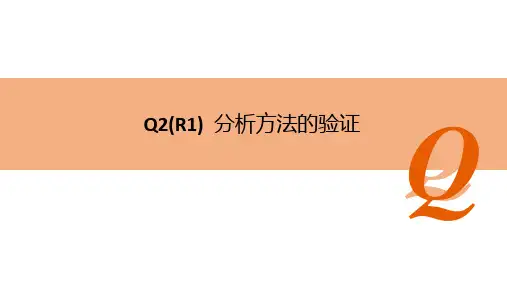
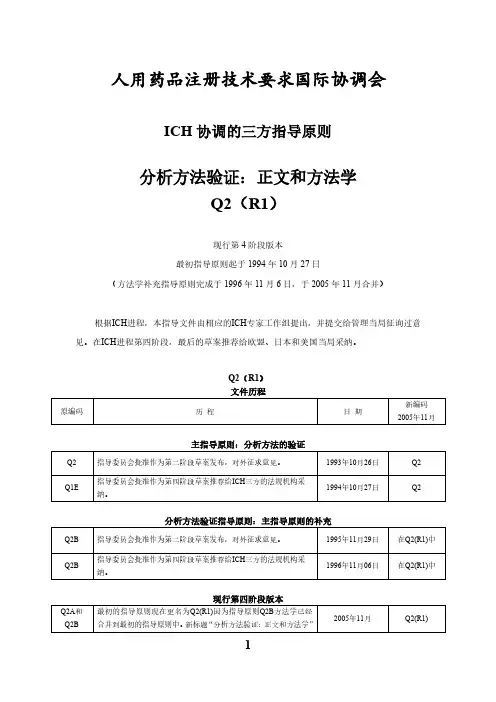
人用药品注册技术要求国际协调会ICH协调的三方指导原则分析方法验证:正文和方法学Q2(R1)现行第4阶段版本最初指导原则起于1994年10月27日(方法学补充指导原则完成于1996年11月6日,于2005年11月合并)根据ICH进程,本指导文件由相应的ICH专家工作组提出,并提交给管理当局征询过意见。
在ICH进程第四阶段,最后的草案推荐给欧盟、日本和美国当局采纳。
Q2(R1)文件历程原编码历程日期新编码2005年11月主指导原则:分析方法的验证Q2 指导委员会批准作为第二阶段草案发布,对外征求意见。
1993年10月26日Q2Q1E 指导委员会批准作为第四阶段草案推荐给ICH三方的法规机构采纳。
1994年10月27日Q2 分析方法验证指导原则:主指导原则的补充Q2B 指导委员会批准作为第二阶段草案发布,对外征求意见。
1995年11月29日在Q2(R1)中Q2B 指导委员会批准作为第四阶段草案推荐给ICH三方的法规机构采纳。
1996年11月06日在Q2(R1)中现行第四阶段版本Q2A和Q2B 最初的指导原则现在更名为Q2(R1)因为指导原则Q2B方法学已经合并到最初的指导原则中。
新标题“分析方法验证:正文和方法学”2005年11月Q2(R1)目录部分1: (3)分析方法的验证正文 (3)1. 介绍 (3)2. 所要验证的分析方法的类型 (3)表 (4)术语 (5)部分2: (7)分析方法的验证方法学 (7)1.专属性 (7)1.1 鉴别 (7)1.2 含量测试和杂质测试 (8)2. 线性 (9)3. 范围 (9)4. 准确度 (10)4.1. 含量分析 (10)4.2. 杂质(定量) (10)4.3 推荐数据 (11)5. 精密度 (11)5.1. 重复性 (11)5.2. 中间精密度 (11)5.3. 重现性 (11)5.4. 推荐数据 (11)6. 检测限 (11)6.1. 根据目测评价 (11)6.2. 根据信噪比 (12)6.3. 根据响应和斜率的标准偏差 (12)6.4 推荐数据 (12)7. 定量限 (13)7.1. 根据目测 (13)7.2. 据信噪比 (13)7.3.1 根据空白的标准偏差 (13)7.4 推荐数据 (13)8. 耐用性 (14)9. 系统适用性测试 (14)部分1:分析方法的验证正文于1994年10月27日经ICH指导委员会批准通过,作为第四阶段草案推荐给ICH的三方法规机构采用。
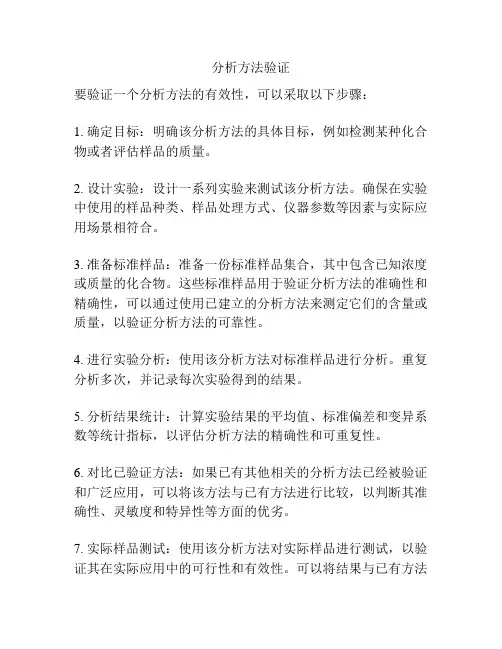
分析方法验证
要验证一个分析方法的有效性,可以采取以下步骤:
1. 确定目标:明确该分析方法的具体目标,例如检测某种化合物或者评估样品的质量。
2. 设计实验:设计一系列实验来测试该分析方法。
确保在实验中使用的样品种类、样品处理方式、仪器参数等因素与实际应用场景相符合。
3. 准备标准样品:准备一份标准样品集合,其中包含已知浓度或质量的化合物。
这些标准样品用于验证分析方法的准确性和精确性,可以通过使用已建立的分析方法来测定它们的含量或质量,以验证分析方法的可靠性。
4. 进行实验分析:使用该分析方法对标准样品进行分析。
重复分析多次,并记录每次实验得到的结果。
5. 分析结果统计:计算实验结果的平均值、标准偏差和变异系数等统计指标,以评估分析方法的精确性和可重复性。
6. 对比已验证方法:如果已有其他相关的分析方法已经被验证和广泛应用,可以将该方法与已有方法进行比较,以判断其准确性、灵敏度和特异性等方面的优劣。
7. 实际样品测试:使用该分析方法对实际样品进行测试,以验证其在实际应用中的可行性和有效性。
可以将结果与已有方法
的结果进行比较,以确保一致性和可靠性。
8. 结果分析:根据验证实验和实际样品测试的结果,评估该分析方法的准确性、可靠性和适用性。
如果结果符合预期,说明该分析方法是有效的。
需要注意的是,在以上步骤中,应该避免使用与标题相同的文字来进行分析方法的验证,以避免歧义和重复。
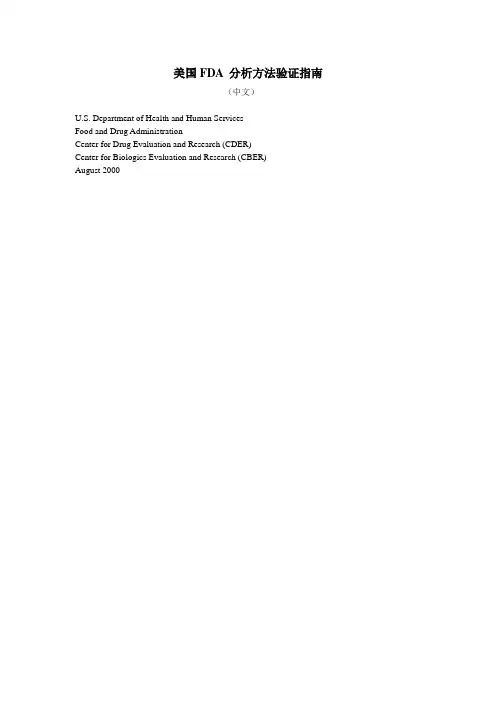
美国FDA 分析方法验证指南(中文)U.S. Department of Health and Human ServicesFood and Drug AdministrationCenter for Drug Evaluation and Research (CDER)Center for Biologics Evaluation and Research (CBER)August 2000目录一、结论………………………………………………………..…………………二、背景……………………………………………………………..……….…..三、分析方法的类型…………………………………………………………….A. 法定分析方法……………………………………………………………B. 替代分析方法……………………………………………………………C. 稳定性指示分析…………………………………………………………四、标准品……………………………………………………………………….. A.标准品的类型……………………………………………………………B.分析报告单………………………………………………………………C.标准品的界定……………………………………………………………五、IND 中的分析方法验证……………………………………………………..六、NDA、ANDA、BLA 和PLA 中分析方法的内容和格式…………………A.基本方法…………………………………………………………………B.取样………………………………………………………………………C.仪器和仪器参数…………………………………………………………. D.试剂………………………………………………………………………E.系统适应性实验…………………………………………………………. F.标准品的制备……………………………………………………………..G.操作过程…………………………………………………………………….H.操作程序……………………………………………………………………I.计算…………………………………………………………………………J.结果报告……………………………………………………………………. 1.通则……………………………………………………………………2.杂质分析规程…………………………………………………………七、NDA,ANDA,BLA 和PLA 中的分析方法验证………………………….. A.非药典分析方法…………………………………………………………1. 验证项目……………………………………………………………2. 其它验证资料……………………………………………………….(1) 讨论可能会形成的异构体并讨论异构体的控制…………………..a. 耐用性…………………………………………………….b. 强降解实验………………………………………………c.仪器输出/原始资料………………………………………i. 有机杂质……………………………………………ii. 原料药……………………………………………….iii. 制剂………………………………………………….(2) 各类检测的推荐验证项目…………………………………………..a. 鉴别………………………………………………………....b. 杂质………………………………………………………..c. 含量………………………………………………………..d. 特定实验…………………………………………………….B.药典分析方法(21CFR 211.194(a)(2))…………………………………..八. 统计分析…………………………………………………………………….A.基本原则………………………………………………………………B:对比研究…………………………………………………………………C:统计………………………………………………………………………九、再验证………………………………………………………………………十、分析方法验证资料:内容和数据处理…………………………………….A.分析方法验证资料…………………………………………………….B:样品的选择和运输…………………………………………………….C:各方职责……………………………………………………………….1.申请人……………………………………………………………….2.化学评审官………………………………………………………….3.FDA 实验室………………………………………………………….4.检查官……………………………………………………………….十一、方法学……………………………………………………………………A.高效液相色谱(HPLC)………………………………………………….1.色谱柱……………………………………………………………….2.系统适应性研究…………………………………………………….3.操作参数…………………………………………………………….B.气相色谱(GC)………………………………………………………….1.色谱柱……………………………………………………………….2.操作参数……………………………………………………………..3.系统适应性实验……………………………………………………..C:分光光度法,光谱法和相关的物理方法………………………………D:毛细管电泳(CE)…………………………………………………………E:旋光度……………………………………………………………………F:和粒径分析相关的分析方法……………………………………………G:溶出度…………………………………………………………………..H:其它仪器分析方法………………………………………………………附录A……………………………………………………………………………….. 附录B……………………………………………………………………………….. 术语表……………………………………………………………………………….一、绪论本指南旨在为申请者提供建议,以帮助其提交分析方法,方法验证资料和样品用于支持原料药和制剂的认定,剂量,质量,纯度和效力方面的文件。
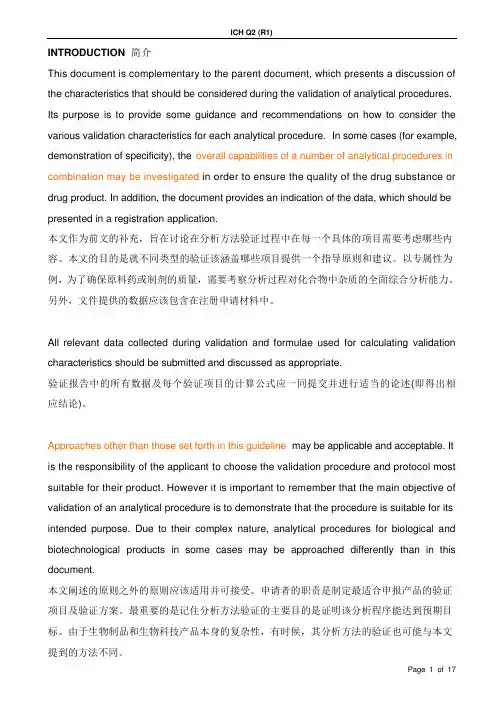
INTRODUCTION 简介This document is complementary to the parent document, which presents a discussion of the characteristics that should be considered during the validation of analytical procedures. Its purpose is to provide some guidance and recommendations on how to consider the various validation characteristics for each analytical procedure.In some cases (for example, demonstration of specificity), the overall capabilities of a number of analytical procedures in combination may be investigated in order to ensure the quality of the drug substance or drug product. In addition, the document provides an indication of the data, which should be presented in a registration application.本文作为前文的补充,旨在讨论在分析方法验证过程中在每一个具体的项目需要考虑哪些内容。
本文的目的是就不同类型的验证该涵盖哪些项目提供一个指导原则和建议。
以专属性为例,为了确保原料药或制剂的质量,需要考察分析过程对化合物中杂质的全面综合分析能力。
另外,文件提供的数据应该包含在注册申请材料中。
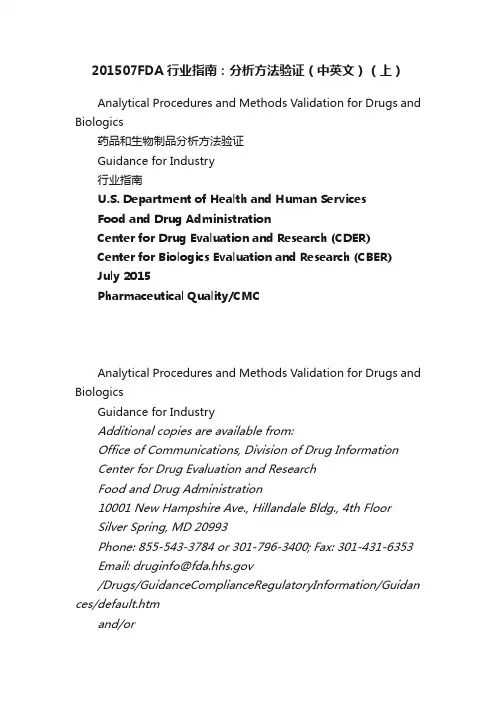
201507FDA行业指南:分析方法验证(中英文)(上)Analytical Procedures and Methods Validation for Drugs and Biologics药品和生物制品分析方法验证Guidance for Industry行业指南U.S. Department of Health and Human ServicesFood and Drug AdministrationCenter for Drug Evaluation and Research (CDER)Center for Biologics Evaluation and Research (CBER)July 2015Pharmaceutical Quality/CMCAnalytical Procedures and Methods Validation for Drugs and BiologicsGuidance for IndustryAdditional copies are available from:Office of Communications, Division of Drug InformationCenter for Drug Evaluation and ResearchFood and Drug Administration10001 New Hampshire Ave., Hillandale Bldg., 4th FloorSilver Spring, MD 20993Phone: 855-543-3784 or 301-796-3400; Fax: 301-431-6353 Email:****************.gov/Drugs/GuidanceComplianceRegulatoryInformation/Guidan ces/default.htmand/orOffice of Communication, Outreach and DevelopmentCenter for Biologics Evaluation and ResearchFood and Drug Administration10903 New Hampshire Ave., Bldg. 71, Room 3128Silver Spring, MD 20993Phone: 800-835-4709 or 240-402-7800Email:************.gov/BiologicsBloodVaccines/GuidanceComplianceRegulatoryInf ormation/Guidances/default.htmU.S. Department of Health and Human ServicesFood and Drug AdministrationCenter for Drug Evaluation and Research (CDER)Center for Biologics Evaluation and Research (CBER)July 2015Pharmaceutical Quality/CMCAnalytical Procedures and Methods Validation for Drugs and Biologics药物和生物制品分析方法验证Guidance for Industry[1]行业指南This guidance represents the current thinking of the Food and Drug Administration (FDA or Agency) on this topic. It does not create any rights for any person and is not binding on FDA or the public. You can use an alternative approach if it satisfies the requirements of the applicable statutes and regulations. To discuss an alternative approach, contact the FDA staff responsible for this guidance as listed on the title page.本指南代表了FDA对本专题的当前想法。
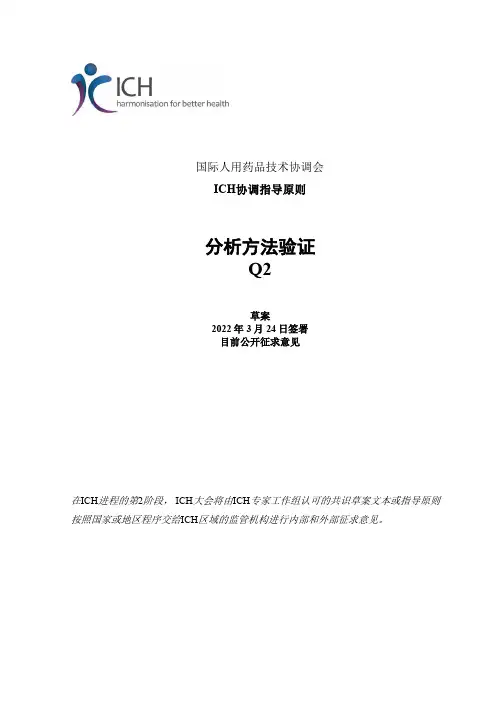
国际人用药品技术协调会ICH协调指导原则分析方法验证Q2草案2022年3月24日签署目前公开征求意见在ICH进程的第2阶段, ICH大会将由ICH专家工作组认可的共识草案文本或指导原则按照国家或地区程序交给ICH区域的监管机构进行内部和外部征求意见。
Q2文件历史法律声明:本文件受版权保护,除ICH标志外,在始终承认ICH拥有本文件版权的前提,基于公开许可可以使用、复制、在其他文件中引用、改编、修改、翻译或传播。
如果对文件进行任何改编、修改或翻译,必须采取合理措施清晰注明、界定或以其他方式标记对原始文件所做的更改。
应避免产生误导使人认为ICH对原始文件的改编、修改或翻译给予批准或认可。
本文件根据现有内容提供,无附带任何形式担保。
在任何情况下,ICH或原始文件的作者均不承担因使用该文件而产生的任何索赔、损害或其他责任。
上述许可不适用于第三方提供的内容。
因此,对于版权归第三方所有的文件,必须获得该版权持有者的转载许可。
ICH协调指导原则分析方法验证Q2ICH共识指导原则目录1引言 (1)2范围 (2)3分析方法验证研究 (2)3.1分析方法生命周期中的验证 (4)3.2可报告范围 (5)3.3稳定性指示特性的证明 (6)3.4多变量分析方法的考虑 (6)3.4.1参比分析方法 (6)4验证试验、方法学和评价 (7)4.1专属性/选择性 (7)4.1.1无干扰 (7)4.1.2正交方法比较 (7)4.1.3技术固有合理性 (7)4.1.4数据要求 (8)4.1.4.1鉴别 (8)4.1.4.2含量测定、纯度和杂质检查 (8)4.2工作范围 (9)4.2.1响应 (9)4.2.1.1线性响应 (9)4.2.1.2非线性响应 (10)4.2.1.3多变量校正 (10)4.2.2范围下限验证 (10)4.2.2.1根据信噪比 (10)4.2.2.2根据线性响应值的标准偏差和标准曲线斜率 (11)4.2.2.3根据范围下限的准确度和精密度 (12)i4.2.2.4数据要求 (12)4.3准确度和精密度 (12)4.3.1准确度 (12)4.3.1.1参比物比较 (13)4.3.1.2加标研究 (13)4.3.1.3正交方法比较 (13)4.3.1.4数据要求 (13)4.3.2精密度 (14)4.3.2.1重复性 (14)4.3.2.2中间精密度 (14)4.3.2.3重现性 (14)4.3.2.4数据要求 (14)4.3.3准确度和精密度的合并评价方式 (15)4.3.3.1数据要求 (15)4.4耐用性 (15)5术语 (16)6参考文献 (24)7附件1验证试验选择 (24)8附件2分析技术例证 (25)ii1引言12本指导原则是讨论药物在ICH成员监管机构注册申请时,递交的分析方法验证所3需考虑的要素。
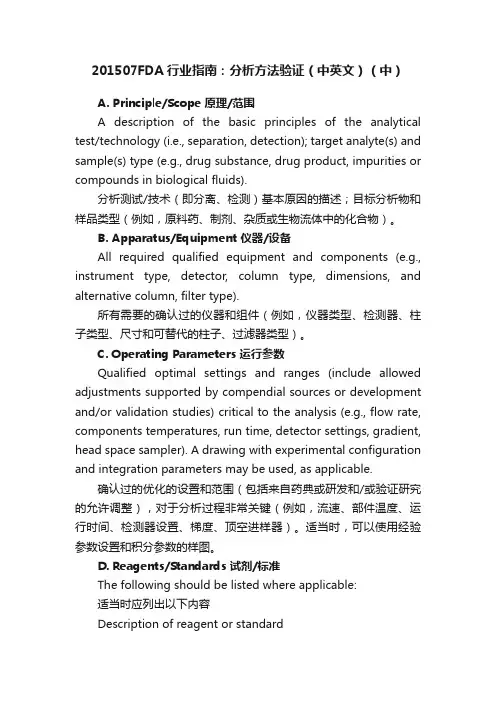
201507FDA行业指南:分析方法验证(中英文)(中)A. Principle/Scope 原理/范围A description of the basic principles of the analytical test/technology (i.e., separation, detection); target analyte(s) and sample(s) type (e.g., drug substance, drug product, impurities or compounds in biological fluids).分析测试/技术(即分离、检测)基本原因的描述;目标分析物和样品类型(例如,原料药、制剂、杂质或生物流体中的化合物)。
B. Apparatus/Equipment 仪器/设备All required qualified equipment and components (e.g., instrument type, detector, column type, dimensions, and alternative column, filter type).所有需要的确认过的仪器和组件(例如,仪器类型、检测器、柱子类型、尺寸和可替代的柱子、过滤器类型)。
C. Operating Parameters 运行参数Qualified optimal settings and ranges (include allowed adjustments supported by compendial sources or development and/or validation studies) critical to the analysis (e.g., flow rate, components temperatures, run time, detector settings, gradient, head space sampler). A drawing with experimental configuration and integration parameters may be used, as applicable.确认过的优化的设置和范围(包括来自药典或研发和/或验证研究的允许调整),对于分析过程非常关键(例如,流速、部件温度、运行时间、检测器设置、梯度、顶空进样器)。
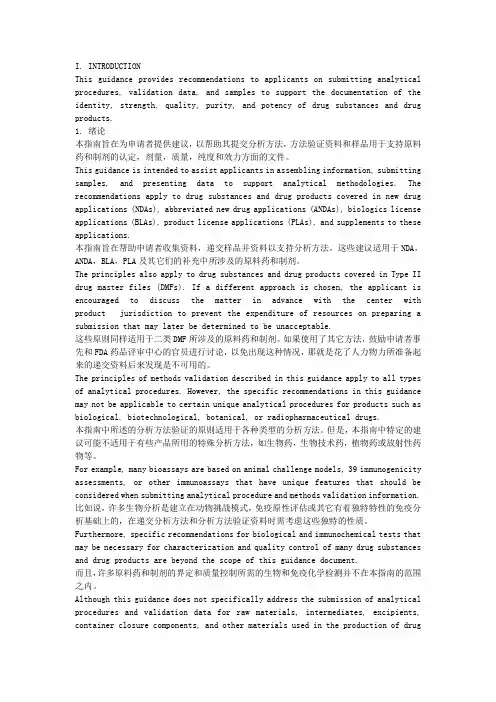
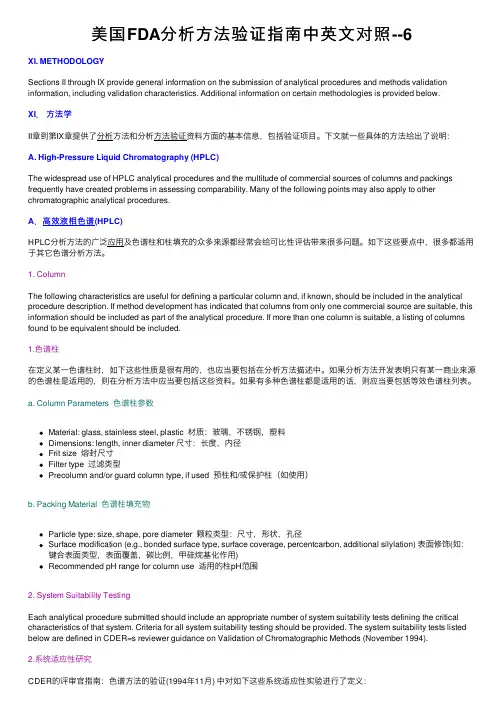
美国FDA分析⽅法验证指南中英⽂对照--6XI. METHODOLOGYSections II through IX provide general information on the submission of analytical procedures and methods validation information, including validation characteristics. Additional information on certain methodologies is provided below.XI.⽅法学II章到第IX章提供了分析⽅法和分析⽅法验证资料⽅⾯的基本信息,包括验证项⽬。
下⽂就⼀些具体的⽅法给出了说明:A. High-Pressure Liquid Chromatography (HPLC)The widespread use of HPLC analytical procedures and the multitude of commercial sources of columns and packings frequently have created problems in assessing comparability. Many of the following points may also apply to other chromatographic analytical procedures.⾊谱(HPLC)⾼效液相⾊谱A.⾼效液相HPLC分析⽅法的⼴泛应⽤及⾊谱柱和柱填充的众多来源都经常会给可⽐性评估带来很多问题。
如下这些要点中,很多都适⽤于其它⾊谱分析⽅法。
1. ColumnThe following characteristics are useful for defining a particular column and, if known, should be included in the analytical procedure description. If method development has indicated that columns from only one commercial source are suitable, this information should be included as part of the analytical procedure. If more than one column is suitable, a listing of columns found to be equivalent should be included.1.⾊谱柱在定义某⼀⾊谱柱时,如下这些性质是很有⽤的,也应当要包括在分析⽅法描述中。
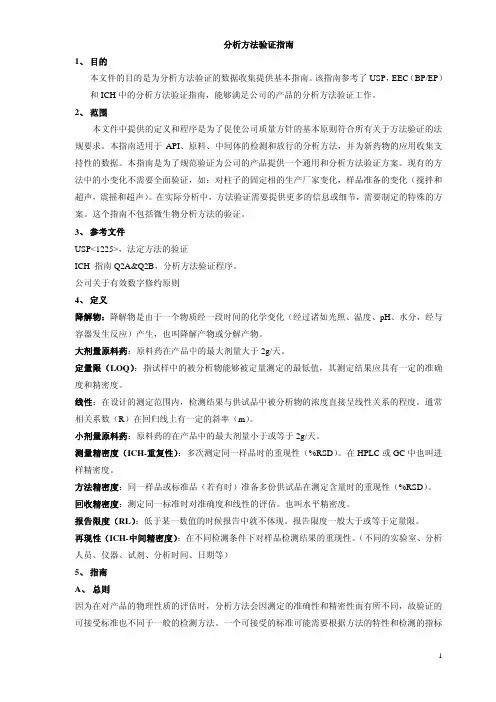
2021年2月总第36卷第1期Feb,2021VOL.36NO.1社科纵横SOCIAL SCIENCES REVIEW从“天下称富庶(到“苦瘠甲天下(——历史时期河陇区域形象变迁考僧海霞赵娇娇(西北师范大学历史文化学院甘肃兰州730030)【内容摘要】区域 是个区域的体和体。
在的中,河陇地区汉唐的繁荣,也了清代以的衰落。
称者陇右”,清代体现出“陇中甲于天下”。
直至今甘肃是贫穷落后的指代。
些述,是的人对甘肃在地域的<的变迁是经社会的变迁,体现的是甘肃地的变动,是国家边的体现。
【关键词】’区域河陇中图分类号:K203文献标识码:A文章编号:1007-9106(2021)01-0154-07河陇是河西、陇右的简称,在中国古代,主要指陇山以西、西域以东的广大地区。
现代研究者大多认为河陇相当于现在的甘肃省或囊括其相邻区域①。
河陇作为一个地理概念,从汉代即被使用,其后成为一个相对稳定的区域指代。
李智君从自然地理区域划分岀发,认为此区域是以陇上黄土高原和河西走廊为主体,其范围约相当于清嘉庆二十五年(1820年)甘肃省的政区范围[1](P12)O此界定将自然和行政区划原,清当。
,河陇地区是中原的西域,是边陲所在,亦是戍守防的重点,其区域<在中西中是中原西出的地,西使所一的地陇西即在此区以,使,甘俱岀陇西”味切。
在中原王朝的边疆经略中,河陇是发的重,者河陇,发展其经济。
在从边地到内郡的过程中,河陇地区应在和的中,理是从地为的地的然河陇地区的相在汉,河陇地区,一,称其称者陇右<的发展,,清情地说:“陇中甲于<”至今河陇即今甘肃则成为贫穷落后的指代。
千余年间,河陇地区的体验怎样的沧桑巨变?曾有种形象变动,惜之过简冈。
河陇作为一个独立的区域,其与社会发展趋势背道驰的区域的基础是什么何变动,其中又暗含怎样的变动机制一系列问题是值得去思考并解析的。
笔者此文即以上述问题为岀发点,探讨河陇区域变迁及其机制,以就教于方家当处,敬请指正。
分析方法验证指南概述“ : “ ” (Q2A Q2B) a ( ).. ().两个关于分析方法验证的指南“分析方法的验证”和“定义/术语和方法学”(Q 2A和Q2B)包括了一个分析方法验证中应该考虑的验证特性的讨论(该指南在讨论中也被应用于兽药产品),它们告诉制药企业在提交申请文件时,需要提供哪些验证数据。
这些数据应证明所提交的检验项目、方法、可接受标准是受控的,足以保证产品放行质量重现性及其生命周期(稳定性)内质量充分受控。
a –, a -, .. , . , :a .由于的工作情况与制药公司并不一样在大多情况下,并没有常规检验,但经常需要在很短时间内做出反应,在进行分析前所要求的方法验证的程度需要再进行考虑。
另一方面,在所有情况下都需要保证所呈交的结果是可靠的。
在此还需要强调的是,在验证研究和分析检测中对照物质均是重要的因素,采用被广泛认可的对照品在某些特定情况下可以避免考虑某些验证特征,这主要表现在生产产品方面,这些需要个案单独判断。
–- , . (. ), (. a ),(. a ; a ), . . : , .本文件的范围—尤其对于来说—是提供验证所需进行的深度的指南,它取决于不同的环境,也就是分析的目的(例如,剔除不符合者),已有验证数据的数量(例如对一个方法进行转移的情况),在单个实验室已有的历史数据和经验(例如,一个复杂矩阵的回收率,即使是对不同物质同样适用的常规标准滴定法)等等。
本文件同等适用于合成产品和生化产品。
本文件未对一般化验室规范提出要求,例如仪器的特定使用、校正等。
a , ; . a , , .(, ) . . .本文件是对指南的一个注释,其中详细说明了验证的深度取决于分析方法的类别,需要注意的是总会有一些其它方法来实现相同目的。
不管怎样,对所选择方法的论述,包括方法本身,应在内部分析文件中做一个简短的描述。
已验证方法(药典、上市文件)的验证数据应该保存可查,对原始的经过验证的方法进行修订需要进行论证。
抗药抗体免疫原性分析方法学验证指导原则摘要:几乎所有的生物制药产品都会引起一定的抗药抗体(anti-drug antibody, ADA)反应,抗药抗体反应可能会降低药物疗效或导致严重的不良反应。
在人体内,抗药抗体通常不会引起明显的临床反应。
但是对于某些治疗性蛋白质,抗药抗体反应能引起各种临床的不良反应,包括温和事件及严重不良事件。
临床前研究表明,抗药抗体能对药物暴露、药物毒性作用、药物代谢动力学、药物效应动力学等造成影响。
因此治疗性蛋白质的免疫原性引起了临床医生、药企及监管机构的注意。
为了评估生物药物分子的免疫原性,以及将实验结果与临床事件联系起来,在临床前研究和临床研究中,很有必要开发可靠的能够有效评估抗药抗体反应的实验方法。
这里方法学验证显得尤为重要,并且方法学验证是药物上市申请必不可少的。
现行的监管文件对于免疫分析方法的验证的指导相当有限,特别是缺乏有关免疫原性分析方法的验证的指导。
因此,本文对抗药抗体免疫分析方法的验证提供科学的建议。
在现有的关于生物分析的规范性文件的基础上加入独特的性能验证。
笔者建议采用实验和统计学的方法进行免疫分析的方法学验证。
这些建议被视为最佳的例子,旨在促进整个医药行业形成一个更加统一的抗体检测方法。
1.简介:生物制药产品包括氨基酸聚合物、碳水化合物或核酸,一般通过人细胞系、哺乳动物细胞或细菌进行表达,比常规的小分子药物更大(一般大于1~3KD)。
由于以上特性,生物制药产品引起免疫反应的潜力更大。
生物制药的免疫原性与产品的内在因素(种属特异性表位、外源性、糖基化程度、聚合或变性程度、杂质和制剂)、外在因素(给药途径、慢性或急性给药、药代动力学及内源性当量)、患者因素(自身免疫性疾病、免疫抑制、和替代疗法)相关。
抗药抗体反应可能会导致严重的临床症状,包括过敏、自身免疫和不同的药代动力学特征(例如,药物中和、生物分布异常和药物清除率增强等均可能会使药物的的疗效发生改变)。
美国XXX药物分析程序及方法验证指导原则(中文版)目录前言本指导原则草案,定稿后,将代表美国食品和药物管理局(XXX)现在关于这个话题现在的想法。
它不会发明或赋予或任何人的任何权利,不束缚XXX或公众。
您可以使用另一种方法,如果该方法符合适用的法律和法规的要求。
如果你想会商一个替换方法,请与XXX工作人员负责实施本指南。
如果你不能肯定恰当的XXX工作人员,请拨打本指南的题目页上所列的电话号码。
介绍:该修订指南草案将取代行业2000年的指导分析方法和方法验证草案,并最终肯定后,也将取代1987年美国XXX行业指南《提交的样品和分析数据的方法验证》。
该草案提供了有关申请人如何提交分析程序和方法验证数据来支持说明质料药和制剂具有强度、质量、纯度和效用的文件。
它会帮你搜集信息和现稀有据来支持你的分析方法。
该指导原则适用于质料药和制剂产物涵盖新药申请(NDA),简化新药申请(仿制药),生物成品许可申请(BLA),以及这些申请的弥补申请。
在这个修订草案指导原则也适用于质料药和制剂产物涵盖二类药物主文件(DMFs)。
该修订指南草案弥补了国际协调会议(ICH)Q2(R1)指导原则《分析程序的验证:开发和验证的分析方法Q2(R1)和方法的文本。
该修订指南草案不触及研究性新药申请(IND)方法验证,但研究者在准备研究性新药申请时应考虑该指导原则中的发起。
研究性新药申请需求在研究的每个阶段有足够的信息,以确保正确鉴别性,质量,纯度,强度和/或效力。
对分析方法和方法验证的信息量将随研究中不同阶段而变化。
有关分析程序和需提交的阶段方法验证材料方面的指导看法的研究中,申请者可以参考XXX的指导原则《Ⅰ期研究药物的IND的内容和格式,包括性状、疗效和生物手艺衍生产物》。
一般考虑在第三阶段的研究举行之前,分析方法和分析方法验证(例如,生物测定)是在XXX行业指导原则《人类药物和生物制剂、化学、制造、控制信息会议》。
该修订指南草案不涉及生物和免疫化学检测的表征和许多原料药和制剂产品质量控制的具体方法验证的建议。
清洁验证之分析方法-下(中英文版)(PDA TR 49内容节选7)6.5 Analytical Method Validation6.5 分析方法验证This section focuses on analytical method validation for “chemical” residues.这部分关注化学残留的分析方法验证Typically, endotoxin methods are compendia methods and do not require formal validation but require a confirmation for their application of use or suitability.内毒素方法是药典方法,不需要正式的验证,但需要使用或者适用性确认。
Microbiological methods that are approved microbiology laboratory methods do not require additional method validation.被微生物学实验室方法批准的微生物方法不需要额外的方法验证。
6.5.1 General Principles6.5.1 基本原则Since one key part of cleaning validation is setting residue limits and then measuring (using an analytical method) the actual residues left on surfaces after cleaning, it is critical that the analytical method be appropriately validated.因为清洁验证主要的一部分是设定残留限度,然后测量(使用分析方法)清洁后表面的实际残留。
美国FDA分析方法验证指南中英文对照(二)上一篇/ 下一篇 2009-01-05 10:44:15 / 个人分类:GMP/GLP查看( 1076 ) / 评论( 2 ) / 评分( 0 / 0 ) III. TYPES OF ANALYTICAL PROCEDURESA. Regulatory A nalytical ProcedureA regulatory analy tical procedure is the analy tical procedure used to ev aluate a def ined characteristic of the drug substance or drug product. The analy tical procedures in the U.S. Pharmacopeia/National Formulary (USP/NF) are those legally recognized under section 501(b) of the Food, Drug, and Cosmetic Act (the Act) as the regulatory analytical procedures f or compendial items. For purpos es of determining compliance with the Act, the regulatory analytical procedure is used.III分析方法的类型A. 法定分析方法法定分析方法是被用来评估原料药或制剂的特定性质的。
USP/NF中的分析方法是法定的用于药典项目检测的分析方法。
为了确认符合法规,需使用法定分析方法。
B. A lternative A nalytical ProcedureAn alternativ e analy tical procedure is an analytical procedure proposed by the applicant f or use instead of the regulatory analy tical procedure. A v alidated alternativ e analy tical procedure should be submitted only if it is shown to perf orm. equal to or better than the regulatory analy tical procedure.B. 替代分析方法替代分析方法是申请者提出用于代替法定分析方法的分析方法。